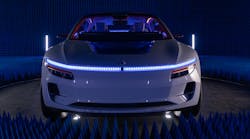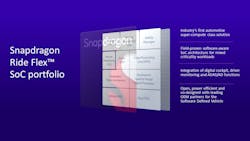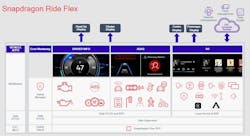This article is part of our CES 2023 coverage.
At CES, Qualcomm introduced a new automotive-grade SoC to serve as the primary control unit for all intelligent functions in a modern car. The company said the new Snapdragon Ride “Flex” SoC can handle both digital cockpit—including dashboard displays and instrument clusters—and advanced driver-assist features on a single chip that’s set to compete with NVIDIA’s upcoming Thor SoC and Mobileye’s EyeQ Ultra.
These tasks typically take place on separate chips embedded in a modern car. But merging them all together into a single high-end chip promises to save costs and reduce complexity of the car’s electronic architecture. Based on 4-nm process technology, Qualcomm said the new Flex SoC is designed from the ground up to safely execute “mixed-criticality” workloads that require varying levels of functional safety—all at the same time.
“We are making it easier and more cost-effective for automakers and Tier-1s to embrace the transition to an integrated, open, and scalable architecture across all vehicle tiers with our pre-integrated suite of hardware, software, and ADAS/AD stack solutions while enabling the ecosystem to differentiate on our platforms,” said Nakul Duggal, senior vice president of the automotive unit at Qualcomm, in a statement.
The new Flex SoC, which is sampling now and scheduled to start mass production in early 2024, is part of the company’s ambitions to build up its automotive business as cars are increasingly powered by software.
Last September, Qualcomm said that the pipeline for its automotive business now stands at about $30 billion, with Tier-1s and OEMs from Volkswagen and Stellantis to General Motors and BMW adopting its automotive-grade chips.
Harder Look at Hardware
As software takes over more responsibilities in vehicles, the hardware under the hood is becoming increasingly important.
Today, more than 100 electronic control units (ECUs) can be distributed throughout a modern vehicle. Each box generally only has enough computing power to do a single task in areas ranging from body control to the powertrain. But as the complexity gets out of control, automakers are moving to “domain-based” architectures that combine many of these single-use modules—and the microcontrollers (MCUs) inside—into several so-called “domain controllers.”
These domain controllers are designed to safely run several separate functions—for instance, ones related to the powertrain or dashboard display—all at the same time. These systems run in separate software containers that coexist in the same high-end processor instead of separate MCUs, reducing the number of physical boxes in the car and, thus, the bill-of-materials (BOM) costs. On top of that, this model reduces the thicket of bulky, heavy, and very expensive wiring that’s tucked inside the vehicle, limiting its overall weight.
NXP last year rolled out a new software development platform called “OrangeBox” that integrates all in-car wireless connectivity, including Wi-Fi and Bluetooth as well as 4G LTE, 5G, and GPS, into a single controller.
High-end chips such as Qualcomm’s Flex SoC also allow automakers to continuously upgrade cars over time with new services and functions as well as add or subtract features via over-the-air (OTA) updates à la Tesla.
Not unlike the rest of its Snapdragon Ride family, the new Flex SoC packs a combination of compute and heterogenous accelerator engines, giving it more than enough performance to go around a modern vehicle (Fig. 1).
The parts of the digital cockpit it will be able to control range from reconfigurable instrument clusters with high-end graphics, premium audio, and dashboard and rear-seat displays for infotainment. It also will have enough headroom to run adaptive cruise control, lane monitoring, parking-assist, driver monitoring, and other safety functions.
Workload Isolation
But to safely consolidate all of these features on a single chip, the new Flex SoC uses a hardware architecture that isolates safety-critical and non-safety-related workloads and keeps them from interrupting each other.
Qualcomm said the Flex SoC comes equipped with a safety island rated for ASIL D–the highest standard for functional safety—that exists as a separate part of the processor to handle faults and recover from failures.
The Flex SoC includes a pre-integrated software platform that can support several rich operating systems, such as Android, Linux, and QNX, at the same time. Hypervisors with isolated virtual machines (VMs) and real-time operating systems with the Automotive Open System Architecture (AUTOSAR) also are supported (Fig. 2).
In addition, Flex is pre-designed to run the Snapdragon Ride “Vision” software stack, which the San Diego, Calif.-based company rolled out at CES last year. It’s able to accurate 360-degree views of the road ahead and any obstacles in the car’s surroundings using a combination of cameras, LiDAR, radar, and other sensors.
Qualcomm said the SoC will come in several different tiers from entry-level to high-end offerings, giving customers the flexibility to choose the one that best suits their needs.
The company introduced Snapdragon Ride back in 2020, and GM said at CES last year that it would be the first to use the new platform to power a new generation of self-driving capabilities in vehicles due out in 2023.
It’s also offering its "Snapdragon Cockpit" chips to run digital dashboards and infotainment features in cars as well as other families of chips to support Wi-Fi and other types of wireless connectivity. Separately at CES, Qualcomm announced that it partnered with Visteon to develop a “high-performance cockpit domain controller” based on its Snapdragon Cockpit chips. The domain controller is apparently set to be used in mass-production vehicles by 2024.
Said Visteon CEO Sachin Lawande, “The automotive cockpit is emerging as a critical competitive battleground in the industry.”
Read more articles from our CES 2023 coverage.


